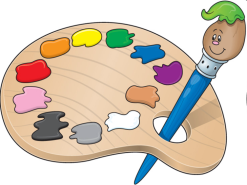|
PRESENTATION AND
PRACTICE
(Activities to present
and activate the new language.)
(D) Teacher presents names of
colours through short visual presentation.
DEMONSTRATION VIDEO
Use a presentation animation
which repeats words and gives learners plenty of opportunities to
produce words.
Pupils pronounce basic
words.
Task
1 (I)
Teacher: Listen!
Repeat!
Teacher
presents the names of colors
through a presentation red, blue, green,
yellow, purple, orange and pupils repeat
.
Descriptor A
learner 
• Listen to the teacher.
Repeat
Assessment.
(appreciate)
Task
2(WC)
POSTER
Pupils ’books closed.
Put up the Pretty Colours! poster on the board. Point to the
colours, one at a time, and say them. The pupils repeat, chorally
and/or individually. Ask the pupils to take out their coloured
pencils. Name a colour, e.g. blue . Ask the pupils to raise their
blue coloured pencil. Repeat with the rest of the
colours.
Pupils ’ books open.
Play the CD. The pupils listen, point to the pictures and repeat
the words. Play the CD again pausing after each word. The pupils
repeat, chorally and/or individually.
Descriptor
A
learner
• The pupils repeat,
chorally and/or individually.
Assessment (smiles)
Task
3 (I)
“Quick nod” Learners listen to
teacher’s sentences, if it is right they nod “yes”, if it is wrong
they nod “no”.
e.g. Is it
red?
Is it
blue?
Assessment (through
observation)
Task
4
“Drawing it in right
colour” (GW)
Learners are given a
worksheet with a picture of traffic lights. Learners listen to
teachers instructions and colour the cirlcles of the traffic
lights.
. 1 A: Stop. What colour is
it? B: Red.
2 A: Get ready. What colour is
it? B: Yellow.
3 A: Go. What colour is it? B:
Green
Descriptor
A
learner
• Learners listen to
teachers instructions
•Color the circles of
the traffic lights.
 (self-assessment) (self-assessment)
Task
4(P
) TPR
Extension activity • For
stronger classes: Select a short exchange from the dialogue for the
pupils to act out in pairs. Allow them some time to rehearse their
exchanges. Have some pairs come to the front of the class and
perform their exchanges.
Red!
Stop!
Yellow
! Get
ready!
Green!
Go!
For weaker classes: Ask some
pupils to take out their story cutouts. Ask them to shuffle them.
Play the dialogue with pauses. The pupils listen and hold up the
corresponding cut outs.
Red! Stop!
Yellow ! Get
ready!
Green! Go!
Assessment (3
claps)
|














